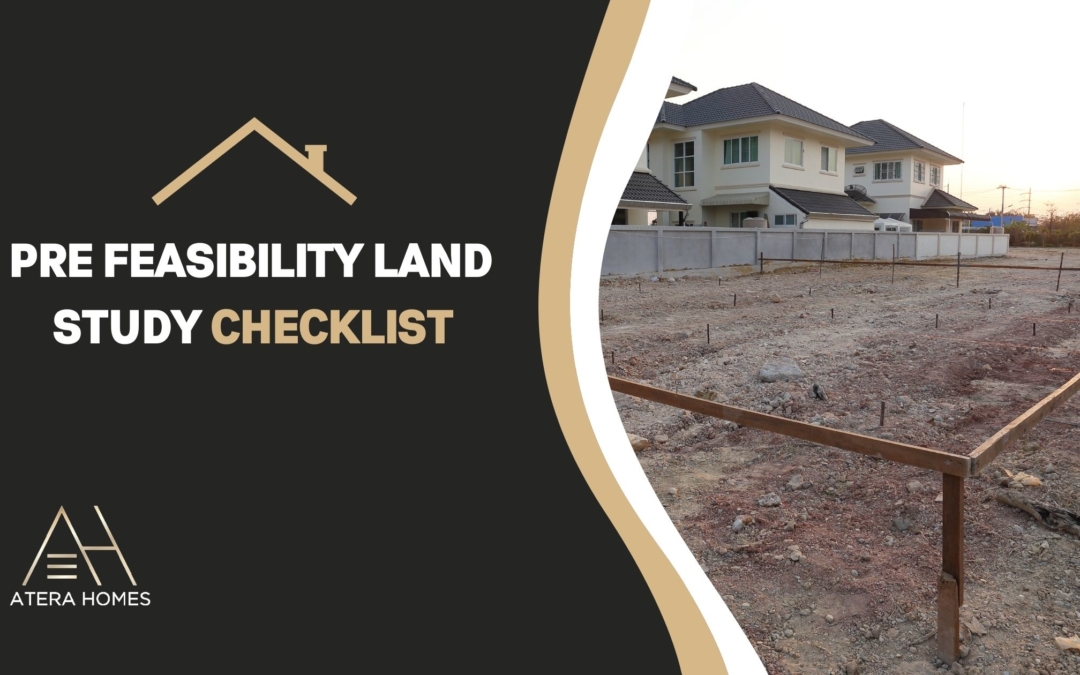Prior to developing a floor plan, future custom homeowners go through feasibility tests. These tests give contractors and owners time to scope out clients’ desired lots and see if they are appropriate for what they’re looking to build. Here are our helpful tips on how to create a pre-feasibility land study checklist of your own.
How to do your own pre-feasibility on a prospective lot?
In order to go through with feasibility assessments, a client will need to pick out a prospective lot to build their home on. A pre-feasibility study checklist narrows lot options down until clients find one they’re willing to test.
Pre-feasibility study checklists will ask specific questions for clients to make decisions on so that they can find the property that will hold their future home. You want your custom home to be on land you see being your forever home not just some spec home that doesn’t meet all of your requirements.
Once you find one or two lots that you like you can begin researching them according to your desired plan. Follow along with our pre-feasibility land study checklist so that we can start the feasibility process. Check out the best neighborhoods in Seattle for families as well as the best neighborhood in Bellevue, WA.
1. Drive by the lot to ensure you like the area, neighborhood, and commute
If you haven’t already, take some time to drive by your desired lot for a more in-depth experience of the neighborhood. Pictures on online listings can only show so much so this is a crucial step for future owners to consider.
Take into account how far this lot is from your work, schools, and other places you expect to frequently visit. Additionally, you may find that factors like privacy may be an issue for certain lots. This is where you can ask yourself how far you’d like to be from others, how the weather can affect the area, and if you like the neighborhood in general.
2. Look up nearby school districts
Finding the most excellent schools in the area you’re looking to live in is a top priority for families. The platform greatschools.org is a finder that will list every school in your vicinity. Each school profile shows ratings in test scores, equity, progress, and more. You can read reviews parents have written as well.
3. Use iMaps to determine size, critical areas, and utilities
King County and most cities offer an application that will display the spatial information of lots. Use the appropriate link to search the prospective lot using the parcel number. Utilize the layers for what you are searching for. If you are trying to locate nearby utility lines and hookups and the property is within city limits, use one of the following corresponding city links below. Please note, if the property is outside of the city limits, you will need to call the utility district.
Bellevue GIS: https://cobgis.maps.arcgis.com/apps/webappviewer/index.html?id=e1748172d4f34f1eb3710032a351cd57
Redmond GIS: https://gis.redmond.gov/uv/
Kirkland GIS: https://maps.kirklandwa.gov/Html5Viewer/
- CHAPTER 15 – LOW DENSITY RESIDENTIAL ZONES (RS, RSX, RSA, WDII, PLA 3C, PLA 6E, PLA 16)
- CHAPTER 20 – MEDIUM DENSITY RESIDENTIAL ZONES (RM 5.0; RMA 5.0; RM 3.6; RMA 3.6; WD I; WD III; PLA 2; PLA 3B; PLA 6F, H, K; PLA 7C; PLA 9; PLA 15B; PLA 17)
Renton GIS: https://maps.rentonwa.gov/Html5viewer/Index.html?viewer=CORmaps
Bothell GIS: https://gismaps.bothellwa.gov/H5/index.html?viewer=COBMap&scale=72192
King County iMaps
King County iMap – King County
4. Assess Subject Lot Dimensions
In iMap, use your ideal floor plan or footprint range to see if the lot’s dimensions can work with them. If you don’t have an idea of floorplan size yet, you can use one at monsefdesigns.com as a reference instead. Learn everything you need to on how to build your own custom home.
General boundary setbacks are 20 feet front and 20 feet back and 15 ft total on the side, 5-foot minimum each.
5. Send in for Review
When the area, school districts, and plot size of a lot all match in your favor, send the property information to us to review.
6. Write an Offer for a Recommended Feasibility Contingency Time
A feasibility contingency time gives buyers the ability to terminate a real estate contract within a specific time period. With the help of Deanna, write up an offer to secure the land with a feasibility contingency; we then can look into the land further to make sure it suits your needs, desired house size, and budget. Buyers then research to determine feasibility.
Specific Things to Look For
As you go about your pre-feasibility land study checklist, ask yourself these additional questions to cover all bases.
- Will your lifestyle be compatible with those in the neighborhood?
- What is the distance to stores, restaurants, and work?
- Will there be nearby development in the future that can affect you, like commercial development?
- How close are you to fire and police stations?
- Is the lot close to places that emit a bothersome amount of noises or smells? Or attract traffic?
- Are there environmental factors that would affect your property?
- What is the teacher-to-student ratio?
- Is there a reliable bus or walking route?
- Has the lot passed tests for utilities like septic systems?
- Is the lot flat or sloped?
- Is there proper access for construction?
- What are the zoning regulations that cover the property? Would any of the neighbors’ zoning rights be a problem?
- Is your desired floor plan compliant with the zoning requirements?
- What are the property taxes? Insurance rates?

